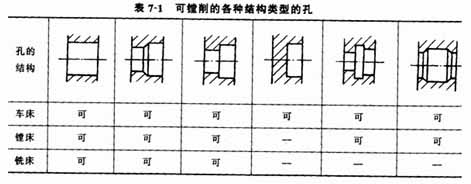L'alésage de l'outil d'alésage à un seul bord présente les caractéristiques suivantes:
(1) L'adaptabilité de l'alésage est forte. Le forage peut être réalisé sur la base du forage, trous de coulée et de forgeage. Une large gamme de niveaux de tolérance dimensionnelle et de valeurs de rugosité de surface réalisables;
Except for the small and deep holes, almost all holes of various diameters and structures can be bored, as shown in Table 7-1.
(2) Boring can effectively correct the position error of the original hole. Cependant, because the diameter of the boring bar is limited by the hole diameter, its rigidity is generally poor, and it is easy to bend and vibrate. Donc, the control of boring quality (especially for elongated holes) is not as convenient as reaming.
(3) The productivity of boring is low. Because boring requires multiple passes with a smaller depth of cut and feed to reduce the bending deformation of the tool bar. En outre, boring on boring machines and milling machines requires adjusting the radial position of the boring tool on the tool bar, so the operation is complicated and time-consuming.
(4) Boring is widely used in the hole processing of various parts in single-piece and small-batch production. En production de masse, boring the bearing holes of the bracket and box body requires a boring die.

Features of boring
 English
English العربية
العربية 中文(漢字)
中文(漢字) Čeština
Čeština Dansk
Dansk Nederlands
Nederlands Suomi
Suomi Français
Français Deutsch
Deutsch Italiano
Italiano 日本語
日本語 ಕನ್ನಡ
ಕನ್ನಡ 한국어
한국어 Português
Português Русский
Русский Slovenčina
Slovenčina Español
Español Svenska
Svenska Türkçe
Türkçe

